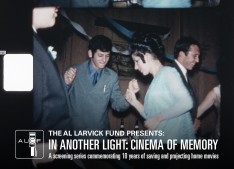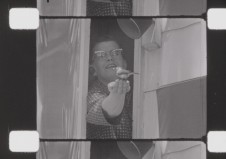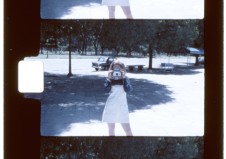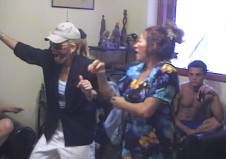In Another Light: Cinema of Memory: A 10 Year Celebration of Home Movies

Los Angeles Filmforum presents
In Another Light: Cinema of Memory: A 10 Year Celebration of Home Movies
Sunday October 5, 2025, 7:30 pm
At 2220 Arts + Archives, 2220 Beverly Blvd., Los Angeles CA 90057
Full info: www.lafilmforum.org
In Another Light: Cinema of Memory
Presented by the Al Larvick Conservation Fund
Recorded intro by Jim Hubbard, in person discussion: Brian Belak, Film preservationist and co-curator
Tickets: $15 general, $10 students/seniors, free for Filmforum members
To mark its 10th anniversary, the Al Larvick Conservation Fund presents In Another Light: Cinema of Memory, a screening series that celebrates the artistry and cultural significance of home movies. These rarely seen amateur films have been given new life through digitization grants from the Fund, and further transformed through curation, editing, and original scores, revealing how personal archives can illuminate shared histories.Al Larvick Conservation Fund
Artistic Impulses (42min)
Curated by Kirsten Larvick & Kelly Burton
Edited by Kimberly Brown
Original Scores by Gene Pritsker
Home movies often depict everyday life, but some makers pushed beyond family chronicles to experiment with form, storytelling, and performance. This program highlights grassroots creators who transformed consumer film and video into works that both document and entertain. Homemade Narratives explores inventive approaches to politics and personal expression, while Life is a Cabaret captures the vibrant world of performance, showing how the act of filming shapes perspective and meaning.
Makers & Presenters: Jim Hubbard – Outside In: Home Movies from Immigrant & Queer Communities (67 min)
Curated & Edited by Jim Hubbard
Filmmaker and activist Jim Hubbard brings together three powerful collections reflecting immigrant and LGBTQ experiences. From the Gonzalez family’s post–Bay of Pigs migration, to Mario Perez’s journey through the Mariel Boatlift and New York’s gay community, to Hubbard’s own long-running documentation of Pride Marches and ACT UP demonstrations, these works reveal how home movies preserve stories often left out of mainstream history. With his curatorial eye, Hubbard demonstrates the power of personal media to record resilience, identity, and underrepresented communities.
Brian Belak is a Film Preservationist for the UCLA Film & Television Archive, where he works on preservation and restoration projects that range from the silent era to independent and LGBTQ+ cinema. Before moving to Los Angeles, Brian worked at Chicago Film Archives, where he first became involved in amateur film preservation and Home Movie Day events. He serves as Board Secretary for the Al Larvick Fund.
Jim Hubbard has been making films since 1974. Among his many films are Nostalgia, United in Anger, Elegy in the Streets, Two Marches, The Dance and Memento Mori, which won the Ursula for Best Short Film at the Hamburg Lesbian & Gay Film Festival. He co-founded MIX - the New York Lesbian and Gay Experimental Film/Video and the ACT UP Oral History Project. Under the auspices of the Estate Project for Artists with AIDS, he created The AIDS Activist Video Collection at the New York Public Library. He has curated film series for the Guggenheim Museum, the New York Public Library and the Museum of Modern Art.
About the Curators & Collaborators
Kirsten Larvick is a preservationist and restoration producer who founded the Al Larvick Fund in 2014. She is Managing Director at IndieCollect, and has co-chaired the Women’s Film Preservation Fund since 2009. Kirsten produces restorations including the Oscar-nominated Asylum and Building Bombs.
Kelly Burton is Media Archivist at the National Gallery of Art and serves as Board Chair of the Al Larvick Fund. A certified archivist and digital specialist, he has led moving image preservation initiatives at institutions including the Montana Historical Society.
Kimberly Brown is a Peabody- and Emmy-winning editor, writer, and producer whose credits span Netflix, Hulu, PBS, Disney, and the Smithsonian. Her work includes award-winning documentaries on Black history, Afrofuturism, and space exploration.
Gene Pritsker is a prolific composer, guitarist, and producer whose works span opera, orchestral, hip-hop, and rock. Founder of Sound Liberation and co-director of Composers Concordance, his projects include Cloud Atlas Symphony, music for The Matrix Resurrections, and collaborations with ensembles worldwide.
About the Al Larvick Conservation Fund
Founded in 2014, the Al Larvick Conservation Fund is a nonprofit dedicated to preserving and providing access to the heritage of amateur and community audiovisual recordings. Through its grant program, ALCF helps families, artists, and organizations digitize and share their collections, ensuring these stories remain part of our cultural history. www.allarvickfund.org
This program is made possible through key collaborators and sponsors. Special thanks to A/V Geeks, Media Burn Archive, The MediaPreserve, Preserve South, and Pro8mm. A very special thanks to all the grant recipients who continue to share their digitized media with family, friends and through the Al Larvick Fund programming.
Screening:
Program 1: Artistic Impulses (42 min)
While home movies traditionally capture domestic life, many makers used their cameras to tell stories, explore culture, and share visions with audiences beyond family. This program highlights inventive approaches to documentaing and performance.
Curated by Kirsten Larvick & Kelly Burton
Edited by Kimberly Brown
Original Musical Score by Gene Pritsker
Recovering Puerto Rican & American Narratives (c. 1980s/1990s, Hi8, color, sound, 3:40 min. Collection holder: Keyvan Heydari)
This intergenerational collection spans the 1940s–1990s and reflects the vision of three family members: Lt. Col. Juan Vázquez Berríos, who filmed military and family life in San Juan; his daughter Carmen Vázquez, an opera singer who documented her travels; and her son Keyvan Heydari, whose footage in this program chronicles a trip Los Angeles with friend in the late 1980s and early 1990s, adding a new generational layer.
Camp Charles H. Grimm & Traffic Safety Parades (1950–1964, 8mm film, color, silent, 1:48 min.. Collection holder: Charles Grimm)
Founded by Alexandria Police Lieutenant Henry Franklin Grimm Sr., Camp Grimm provided no-cost summer experiences for Virginia youth. Supported by the AAA, the camp combined traffic safety lessons with classic activities like softball, swimming, fishing, and movie nights. Filmed by AAA staff, the footage reflects recreation, civic instruction, and mid-century youth culture.
Dwight Core Collection (c. 1950s, 4:32 min, 16mm, b&w, silent, 4:32 min. Collection holder: George Ingmire)
Dwight L. Core (1921–1995), a native of West Virginia, served in the Air Force before working as a photographer in Virginia. His films document small-town life alongside documentary studies of silkworms and farm work. One film, Think of Me First as a Person, a portrait of his son, was named to the National Film Registry in 2006. An ALCF grant in 2020 digitized half of the remaining collection.
Missouri Fiddlin’: The Anthony Collins Collection (1970s/1980s, U-Matic, b&w, sound, 4:49 min. Collection holder: Anthony Collins)
Dr. E. Anthony Collins, a documentary filmmaker and musician, recorded Missouri fiddlers in the late 1970s and 1980s while a student at UCLA. He developed a close bond with Emanuel Wood (1900–1981) and his family, capturing their artistry alongside other musicians. The collection spans film, video, audio, and photographs, preserving a vibrant tradition of American folk music.
President John F. Kennedy and Senator Robert Kennedy Home Movies (c. 1959–1968, 8mm, color, silent, 3:00 min. Collection holder: Ron Merk)
Amateur filmmaker Augustus Sassa (1927–1995) recorded John and Robert Kennedy in the 1960s, including extensive coverage of JFK’s funeral. Stored in a family safe deposit box for 50 years, the reels were later acquired by the Metro Theatre Center Foundation and received film-based restoration support from the National Film Preservation Foundation. The Al Larvick Fund provided high-resolution scans.
Domarecki-Boskind Family Baltimore Historical Films (1940s, 16mm, color, silent, 2:02 min.. Collection holder: Brian Boskind)
Stephen J. Domarecki (1912–1974), son of Polish immigrants, filmed Baltimore life from the 1940s to the 1970s. His movies feature family gatherings, local theaters like the Hippodrome and Band Box, and nightlife in clubs such as The Spa and Blue Room. While serving in the Navy’s Seabees, he also filmed naval games in Hawaii and the Aleutian Islands, expanding the family’s archive beyond Baltimore.
Casper J. Renner Home Movies & Community History Collection (mid-20th century, 18mm, color, silent, 1:21 min. Collection holder: Carol Renner)
Casper “Cap” Renner (1917–2002), mayor of Richardton, North Dakota for more than 30 years, filmed family milestones, rodeos, and parades alongside community events. Proud of his German Russian heritage, Renner created a portrait of small-town life that reflects civic identity and cultural traditions across four decades.
Dalles and Susan Schneider Family Films (1970s–1980s, Super 8, color, silent, 2:06 min. Collection holder: Dalles Schneider)
Dalles Schneider documented his family’s life in North Dakota through Super 8 films featuring weddings, baptisms, holidays, and school events. The reels also show farm work, threshing bees, and parades, highlighting generational traditions and everyday life. His wife Susan, their children, and extended relatives in Norway all recorded to film. This scene is of a “muscle man” themed birthday party.
The Films of Arthur H. Virtue (c. 1930s, 16mm, b&w, silent, 2:17 min. Collection holder: Virginia Errechetti)
Arthur H. Virtue (1914–1986) experimented with trick shots, double exposures, and playful editing, while also documenting Atlantic City life from the 1930s to the 1970s, where he worked at a beach umbrella rental stand. His films include family trips to New York and Philadelphia, boardwalk scenes, and promotional material repurposed for his own home movies. This footage includes many shots spliced in from a Steel Pier advertisement film.
Mario Perez Video Collection (1996–2009, 3Hi8 & MiniDV, color, sound, 3:39 min.. Collection holder: Mario Perez)
Mario Perez, born in San Antonio de los Baños, Cuba, came to the U.S. during the 1980 Mariel Boatlift. He documented New York’s queer community, capturing friendships, life around Christopher Street and Chelsea neighborhoods, and trips back to Cuba. This program features two self-portrait style recordings.
James Kilgore Film Collection (c.1980s, 8mm, color, sound, 2:14 min. Collection holder: Nashville Metro Archives)
Nashville native James Kilgore (1919–2014) filmed for over four decades, from family movies to travelogues and his military experiences. Believed to be a member of the Amateur Cinema League, he embraced storytelling on film. Featured here is a reel from Summer Lights festival, Nashville, Tennessee.
H.E. Englert Family Home Movies (c.1940s, 8mm, color, silent, 1:44 min.. Collection holder: Darlene Englert Talbott)
Hamilton Englert (1909–1998), a judge in Valley City, North Dakota, began filming in 1940. His reels include holidays, neighbors, pets, and playful moments with his daughters Darlene and Ann. The featured reel 'Darlin’ Hats' captures a lighthearted scene with Englert’s daughters.
Barbara’s Little House of Flowers (1950s–1970s, Super 8, color/b&w, silent, 3:41 min. Collection holder: Emma Kemp)
Barbara Joan Reisner (1932–2020) filmed home life in Los Angeles, California, family, friends, and travels across the U.S. and Europe with curiosity and creativity. Her footage include footage of ballerina Alexandra Danilova, whom she befriended as a teen, alongside images of pets, parades, and landscapes. Highlighted here are rehearsals, performances and travel with Danilova. Barbara’s tenant, Emma Kemp is the custodian of her vast archive of personal art and films.
Larry Buttwinick Film Collection (c. 1965–1975, Super 8, color, silent, 4:21 min.. Collection holder: GLBT Historical Society)
Larry Buttwinick (1924–2004), a gay Jewish WWII veteran and San Francisco resident, was an early member of the Imperial Court founded by José Sarria. His collection, housed at the GLBT Historical Society, include this reel of a drag party, preserving the artistry, joy, and community of queer life in San Francisco during a formative era.
Program 2: Outside In: Home Movies from Immigrant & Queer Communities (67 min)
Curated and edited by Jim Hubbard, this program interweaves three collections reflecting migration, identity, and activism.
The Immigrant Experience, Part I – From Assimilation to Tourism (1968–1986, 8mm, VHS, color, silent/sound, 8 min.)
The Gonzalez Family emigrated from Cuba after the Bay of Pigs. Their films capture resilience and pleasure: visits to relatives in Spain, trips abroad, and quintessential American moments at Disneyland and in the snow in Astoria, Queens, New York.
The Immigrant Experience, Part II – Community and Family (1996–2009, Video8, MiniDV, color, sound, 11 min.)
Mario Perez came to the U.S. during the Mariel Boatlift of 1980 and later built a life in New York’s gay community. His tapes show friendships, memorials, nightlife, and trips back to Cuba, reflecting both exile and belonging.
Pride and Activism, Part III (1979–2009, 8mm & 16mm, b&w/color, silent, 37 min.)
Jim Hubbard has filmed every Pride March since 1978, alongside ACT UP demonstrations. His footage traces both the celebratory and political sides of queer life, preserving a grassroots record of community struggle and resilience.
To watch trailers from previous Al Larvick Fund screening programs, visit our Vimeo page at:

Homemade Narratives
Homemade Narratives
While home movies often capture everyday life, some makers used them to explore wider interests and curiosities. This program highlights grassroots creators experimenting with storytelling, politics, and culture—work that entertains, documents, and challenges. Homemade Narratives traces the evolution of these inventive approaches, while Life is a Cabaret examines performance in home movies, showing how filming itself shapes perspective and meaning.
Curated by Kirsten Larvick & Kelly Burton; edited by Kimberly Brown; original scores by Gene Pritsker.

Life is a Cabaret
Life is a Cabaret
Life is a Cabaret traverses the diverse landscape of “performance” in home movies. The act of recording motion can inspire and influence its surroundings, just as a performance can direct a maker’s point of view. The Larry Buttwinick Film Collection highlights the life of Larry Buttwinick (1924–2004), a gay Jewish activist and founding member of San Francisco’s Imperial Court. Born in Boyle Heights, he served in WWII before moving to San Francisco in 1954, where he was active in LGBTQ organizations, including the Society for Individual Rights and Lavender Seniors of the East Bay. A surviving 8mm film reel from 1965–1975 captures intimate pre-show gatherings among Buttwinick and friends, offering a rare glimpse into San Francisco’s drag and LGBTQ social scene. The Domarecki-Boskind Family Baltimore Historic Films showcase the home movies of Stephen J. Domarecki (1912–1974). Born to Polish immigrants in New Jersey, he danced in marathons during the Great Depression, eventually meeting his wife, Sheila, a performer with the June Taylor and Stardust Dancers, in Baltimore. His films capture the city's vibrant entertainment scene, including performances at the Hippodrome Theater, the Band Box, and Club Charles. Additional collections include Barbara’s Little House of Flowers; Closet Ball Beta Tape Collection; Casper J. Renner Home Movies; Arthur Virtue Film Collection.

Makers & Presenters: Jim Hubbard
Makers & Presenters: Jim Hubbard
60 min. This program spotlights filmmaker and artist Jim Hubbard, who brings together three collections reflecting immigrant and LGBTQ experiences. From the Gonzalez family’s post–Bay of Pigs migration, to Mario Perez’s journey through the Mariel Boatlift and New York’s gay community, to Hubbard’s own documentation of Pride Marches and ACT UP, these works share his curatorial vision and lifelong commitment to amplifying underrepresented histories.
Curated and edited by Jim Hubbard.
